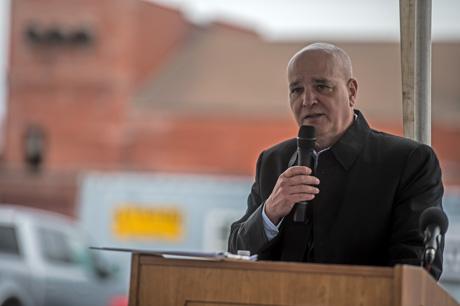Sam Savarino cited a loss of more than $3.3 million that stemmed from a construction job at SUNY Alfred State College as reason for closing his Savarino Companies, and therefore leaving Batavia's Ellicott Station apartment complex in the lurch this week.
Savarino sent The Batavian a four-page outline detailing what had transpired during that job, and we wanted to publish that explanation, albeit lengthy over the course of three years, here.
It began with DASNY
Savarino had a contract with the Dormitory Authority of the State of New York, known as DASNY, to perform the construction of a student housing project at Alfred. The project was called MacKenzie Hall Phase III renovation and associated asbestos abatement. It was broken down into three phases, and phase 3A was to be done before 3B and 3C were to begin, Savarino said, though there was some overlap between all three phases.
The pandemic plays a role
Soon after Savarino began the work in March 2020, it was suspended by DASNY due to COVID-19 and state executive orders. Savarino reserved its rights based on the project shutdown, and DASNY eventually determined that the work would resume on May 18, 2020, and the schedule would be reset. Phase 3A was then to be completed by July 23, 2021.
Phases 3B and 3C were to begin on May 17, 2021, and Savarino objected to the schedule that was being imposed and reserved all of its rights, he said. He moved toward completion of Phase 3A and also began certain work on the other two phases.
Alfred's change of plans
On April 30, 2021, more than two and a half months prior to the required substantial completion of Phase 3A work, DASNY informed Savarino that Phase 3B and 3C were being put on pause, Savarino said. Alfred College had determined that it needed to continue the use of dormitory rooms that would have been renovated as part of Phase 3B and 3C. No other reason was given at that time, Savarino said.
For a variety of reasons, including COVID-19, supply chain issues, shortage of labor issues, owner delay issues (e.g., late change order work and failure to require design professionals to timely respond to Savarino requests for information and assistance) and other issues that were not attributable to Savarino, the Phase 3A work was not substantially completed by DASNY’s imposed date of July 23, 2021, Savarino said.
He was issued a temporary approval of occupancy by DASNY on or about Nov. 3, 2021, with respect to Phase 3A. Completion of “punch-list” items was still remaining.
Terminating services
Notwithstanding its approval of occupancy, DASNY provided notice to Savarino on Nov. 4, 2021, that it intended to terminate Savarino with respect to the Phase 3A work and the remainder of the project, being the Phase 3B and 3C work that DASNY had paused back on April 30, 2021.
Savarino contested its termination in writing on Nov. 16, 2021, as well as during a conference call that was afforded to Savarino on that day, he said. By letter dated Nov. 19, 2021, DASNY terminated Savarino, purportedly for cause. Savarino has objected to its termination and has claimed that DASNY has breached the contract. Savarino has reserved all rights.
Good faith punch list
Notwithstanding the Nov. 19, 2021 termination, Savarino and its subcontractors continued to perform in good faith the “punch-list” items on the Project until DASNY terminated Savarino’s right to do that on or about Dec. 7, 2021. This punch-list work could have been completed within a short period of time, But DASNY required that it have in place a take-over agreement with Savarino’s surety, Endurance Assurance Corp., before any work could continue. This would prove to delay completion of the work, he said.
On DASNY’s demand, Endurance agreed to complete the work on the Project. Endurance requested that the surety be permitted to hire Savarino as its contractor to complete the work. This was a permitted alternative under the performance bond, but that alternative required the owner’s consent. DASNY flatly refused, Savarino said.
Completion/Takeover Agreement
Eventually, Endurance and DASNY entered into a Completion/Takeover Agreement that was executed on April 5, 2022. This allowed the completion of the Phase 3A “punch-list” work and set new dates for completion of the Phase 3B and 3C work. The surety hired Loewke–Brill Consulting Group as its representative and replacement contractor, all at great cost to Savarino, he said.
While the agreement provided Savarino with the ability to assist Loewke–Brill, he was essentially barred from the site. Savarino assisted in scheduling, continuing subcontracts with subcontractors, payment applications and other matters to progress the work. DASNY’s own actions delayed the completion of the Project, he said.
The “pause” on the Phase 3B and 3C work on April 30, 2021, for the convenience of Alfred State College, cannot be attributable to Savarino, he said, and its refusal to allow work on the Project to proceed until the Completion/Takeover Agreement was signed on April 5, 2022, further delayed the Project.
Building his case
Savarino denies that it was appropriate for DASNY to terminate his work on the Project. Savarino said he believes that the termination resulted from deteriorating relationship between Alfred State College and DASNY and DASNY’s attempt to “save face” by blaming Savarino for delays in the completion of the Project.
Savarino further believes, according to his email, that, in any event, other causes contributed to the delay in completion of the Project. Savarino has engaged an expert to study the delays that he incurred that were outside of his control, and preliminary indications from that expert indicate that an extension of time in favor of Savarino for the Phase 3A work beyond DASNY’s imposed date of July 23, 2021, would be appropriate.
Moreover, the contract with DASNY provides for liquidated damages for a delay in project completion. If these are appropriate in amount and not unenforceable as a penalty, that would provide DASNY its remedy for delay in completion.
Savarino believes that, in any event, Alfred State College was not materially impacted by the delay in completion of Phase 3A. The students that would have occupied Phase 3A were housed in other facilities on campus, he said.
Filing his lawsuit
On Nov. 15, 2022, Savarino filed a lawsuit against DASNY in the Supreme Court of the State of New York, with the venue in the County of Albany, to seek an adjudication of the respective claims of the parties. That lawsuit is now in the discovery stage.
It should be noted, he said, that Phase 3B of the Project achieved a temporary approval for occupancy as of Aug. 11, 2023, and is now being occupied. It is anticipated that Phase 3C will be completed by the anticipated date of Nov. 24, 2023, as set forth in the Completion/Takeover Agreement with Endurance.
Savarino claims that it has been severely impacted by DASNY’s actions on this Project. Savarino will be seeking damages from DASNY in the currently pending action, he said.
Savarino included an attachment that tallied estimated damages of $3,310,282.82 based on the increased costs and legal fees that Savarino incurred that were caused by DASNY’s actions.

































